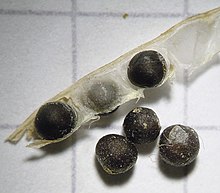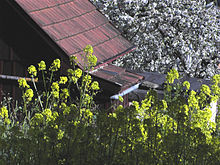Field mustard
| Field mustard | ||||||||||||
|---|---|---|---|---|---|---|---|---|---|---|---|---|

Field mustard ( Sinapis arvensis ) |
||||||||||||
| Systematics | ||||||||||||
|
||||||||||||
| Scientific name | ||||||||||||
| Sinapis arvensis | ||||||||||||
| L. |
The Sinapis arvensis ( Sinapis arvensis ), Wrong Hederich or wild mustard is a plant type from the kind of mustards ( Sinapis ) within the family of Brassicaceae (Brassicaceae). The species was already a common "weed" in the Bronze Age .
description
Field mustard is an annual herbaceous plant that reaches heights of 20 to 60 cm. The stem is hairy in the lower part. The lower leaves are up to 20 cm long, stalked and strongly articulated to lyre-shaped pinnate with a large end section.
The hermaphroditic, radially symmetrical flower is fourfold. The four sepals are horizontal. The four petals are sulfur yellow. The flower has six long stamens , two of which are on the outside and four on the inside.
The pod is glabrous, stem-round and constricted somewhat like a string of pearls with 8 to 13 black seeds in two compartments and three to five straight, strong nerves on each fruit valve. The pod ends in a 1 to 1.5 cm long, almost round, straight beak.
The flowering period extends from May to October.
The number of chromosomes is 2n = 18.
Occurrence
Field mustard is an archaeophyte and was introduced with agriculture from the Mediterranean area to the northern regions of Europe. Its home area is Europe, Asia and North Africa. In the temperate zones it is also widespread worldwide today.
Field mustard is widespread in weed corridors, on fallow land, on paths and rubble sites. It prefers soil rich in nutrients and bases, is a clay pointer and often occurs in large groups. It thrives in Central Europe in societies of the associations Caucalidion, Aperion, Fumario-Euphorbion or Sisymbrion.
According to Ellenberg , it is a half-light plant, a moderate heat pointer and a class character of the cereal weed corridors (Secalietalia). Field mustard grows on the plains and in the mountains up to an altitude of 1000 m, according to Oberdorfer even up to 1230 m.
Systematics
One can distinguish between two subspecies:
- Sinapis arvensis L. subsp. arvensis
- Sinapis arvensis L. subsp. allionii (Jacq.) Baillarg. : It only occurs in Egypt.
ecology
The field mustard is summer annual and has roots over a meter deep.
Its flowers are homogeneous to feminine "nectar-carrying disc flowers". They have a lifespan of two days. The calyx rests on the open flowers, which is why the nectar is offered openly. The pollen- donating side of the anthers points upwards at maturity. The yellow petals have a high UV reflection, except in the central part. Pollinators are beetles , bees , flies, and butterflies . It is a good pasture for bees. However, self-pollination is common.
The fruits are pods with a seed-free top section. They open themselves by drying out. The species is a self, wind and animal litter. The expansion of people has made it a cultural companion. The spherical seeds have a seed coat that swells up slimy when wet. This also spreads the glue. Vigorous specimens can produce up to 25,000 seeds. The seeds can germinate for many years, but only germinate near the surface of the soil.
Pungent smelling, hot mustard oils protect wounded plants from fungal attack and herbivores. However, the caterpillars of the cabbage white flies prefer plants with mustard oils, which are still detectable in the adult butterflies and protect them from predators.
use
The seeds can be mixed with those of white mustard ( Sinapis alba ). Finely chopped leaves can serve as a spice . Flower buds can be cooked like broccoli . Herbaceous parts are suitable as vegetables after long cooking .
swell
literature
- Oskar Sebald: Guide through nature. Wild plants of Central Europe . ADAC Verlag, Munich 1989, ISBN 3-87003-352-5 .
- Margot Spohn, Marianne Golte-Bechtle: What is blooming there? The encyclopedia: over 1000 flowering plants from Central Europe. Kosmos, Stuttgart 2005, ISBN 3-440-10326-9 .
- Tai-yien Cheo, Lianli Lu, Guang Yang, Ihsan Al-Shehbaz, Vladimir Dorofeev: Sinapis. In: Wu Zheng-yi, Peter H. Raven (Ed.): Flora of China . Volume 8: Brassicaceae through Saxifragaceae . Science Press / Missouri Botanical Garden Press, Beijing / St. Louis 2001, ISBN 0-915279-93-2 , pp. 23 (English, online - PDF file ).
Individual evidence
- ↑ a b c d e Erich Oberdorfer : Plant-sociological excursion flora for Germany and neighboring areas . With the collaboration of Angelika Schwabe and Theo Müller. 8th, heavily revised and expanded edition. Eugen Ulmer, Stuttgart (Hohenheim) 2001, ISBN 3-8001-3131-5 , pp. 439 .
- ↑ a b Sinapis in the Germplasm Resources Information Network (GRIN), USDA , ARS , National Genetic Resources Program. National Germplasm Resources Laboratory, Beltsville, Maryland. Retrieved July 19, 2017.
- ↑ Heinz Ellenberg : Vegetation of Central Europe with the Alps in an ecological, dynamic and historical perspective (= UTB for science. Large series . Volume 8104 ). 5th, heavily changed and improved edition. Eugen Ulmer, Stuttgart (Hohenheim) 1996, ISBN 3-8252-8104-3 .
- ↑ a b c d e Ruprecht Düll , Herfried Kutzelnigg : Pocket dictionary of plants in Germany. A botanical-ecological excursion companion to the most important species . 6th, completely revised edition. Quelle & Meyer, Wiebelsheim 2005, ISBN 3-494-01397-7 , p. 442-443 .
Web links
- Field mustard. In: FloraWeb.de.
- Field mustard . In: BiolFlor, the database of biological-ecological characteristics of the flora of Germany.
- Sinapis arvensis L. In: Info Flora , the national data and information center for Swiss flora . Retrieved October 24, 2015.
- Distribution in the northern hemisphere according to: Eric Hultén , Magnus Fries: Atlas of North European vascular plants 1986, ISBN 3-87429-263-0 .
- Thomas Meyer: Data sheet with identification key and photos at Flora-de: Flora von Deutschland (old name of the website: Flowers in Swabia )
- Heilkräuter.de - Field mustard as a medicinal plant
- Entry at GRIN.




